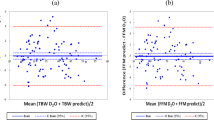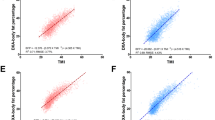Abstract
Objective: To compare percentage body fat (%BF) for a given body mass index (BMI) among New Zealand European, Maori and Pacific Island children. To develop prediction equations based on bioimpedance measurements for the estimation of fat-free mass (FFM) appropriate to children in these three ethnic groups.
Design: Cross-sectional study. Purposive sampling of schoolchildren aimed at recruiting three children of each sex and ethnicity for each year of age. Double cross-validation of FFM prediction equations developed by multiple regression.
Setting: Local schools in Auckland.
Subjects: Healthy European, Maori and Pacific Island children (n=172, 83 M, 89 F, mean age 9.4±2.8(s.d.), range 5–14 y).
Measurements: Height, weight, age, sex and ethnicity were recorded. FFM was derived from measurements of total body water by deuterium dilution and resistance and reactance were measured by bioimpedance analysis.
Results: For fixed BMI, the Maori and Pacific Island girls averaged 3.7% lower %BF than European girls. For boys a similar relation was not found since BMI did not significantly influence %BF of European boys (P=0.18). Based on bioimpedance measurements a single prediction equation was developed for all children: FFM (kg)=0.622 height (cm)2/resistance+0.234 weight (kg)+1.166, R2=0.96, s.e.e.=2.44 kg. Ethnicity, age and sex were not significant predictors.
Conclusions: A robust equation for estimation of FFM in New Zealand European, Maori and Pacific Island children in the 5–14 y age range that is more suitable than BMI for the determination of body fatness in field studies has been developed.
Sponsorship: Maurice and Phyllis Paykel Trust, Auckland University of Technology Contestable Grants Fund and the Ministry of Health.
This is a preview of subscription content, access via your institution
Access options
Subscribe to this journal
Receive 12 print issues and online access
$259.00 per year
only $21.58 per issue
Buy this article
- Purchase on Springer Link
- Instant access to full article PDF
Prices may be subject to local taxes which are calculated during checkout


Similar content being viewed by others
References
Bland JM & Altman DG . (1986): Statistical methods for assessing agreement between two methods of clinical measurement. Lancet i, 307–310.
Cole TJ, Bellizzi MC, Flegal KM & Dietz WH (2000): Establishing a standard definition for child overweight and obesity worldwide: international survey. Br. Med. J. 320, 1–6.
Daniels SR, Khoury PR & Morrison JA (1997): The utility of body mass index as a measure of body fatness in children and adolescents: differences by race and gender. Pediatrics 99, 804–807.
Davey Smith G, Greenwood R, Gunnell D, Sweetnam P, Yarnell J & Elwood P (2001): Leg length, insulin resistance, and coronary disease risk: the Caerphilly Study. J. Epidemiol. Commun. Health 55, 867–872.
Deurenberg P, Pieters JJL & Hautvast JGAG (1990): The assessment of the body fat percentage by skinfold thickness measurements in childhood and young adolescence. Br. J. Nutr. 63, 293–303.
Deurenberg P, van der Kooy K, Leenen R, Westrate JA & Seidell JC (1991): Sex and age specific prediction formulas for estimating body composition from bioelectrical impedance: a cross-validation study. Int. J. Obes. Relat. Metab. Disord. 15, 17–25.
Fomon SJ, Haschke F, Ekhard ZE & Nelson SE (1982): Body composition of reference children from birth to age 10 years. Am. J. Clin. Nutr. 35, 1169–1175.
Freedman DS, Srinivasan SR, Valedz RA, Williamson DF & Berenson GS (1997): Secular increases in relative weight and adiposity among children over two decades: the Bogalusa Heart Study. Pediatrics 99, 420–426.
Guo S, Roche AF & Houtkooper L (1990): Fat-free mass in children and young adults predicted from bioelectric impedance and anthropometric variables. Am. J. Clin. Nutr. 50, 435–443.
Guo SS & Chumlea WC (1996): Statistical methods for the development and testing of predictive equations. In Human Body Composition, eds. AF Roche, SB Heymsfield & TG Lohman, pp 191–202. Champaign, IL: Human Kinetics.
Houtkooper LB, Going SB, Lohman TG, Roche AF & van Loan M (1992): Bioelectrical impedance estimation of fat-free body mass in children and youth: a cross-validation study. J. Appl. Physiol. 72, 366–373.
Howden-Chapman P & Tobias M (2000): Social Inequalities in Health: New Zealand 1999. Wellington: Ministry of Health.
IDECG (1990): The doubly-labelled water method for measuring energy expenditure. Technical recommendations for use in humans. A consensus report by the International Dietary Energy Consultancy Group. International Atomic Energy Agency: Vienna.
Kyle UG, Genton L, Karsegard L, Slosman DO & Pichard C . (2001): Single prediction equation for bioelectrical impedance analysis in adults aged 20–94 years. Nutrition 17, 248–253.
Leitch I (2001): Growth and health. Int. J. Epidemiol. 30, 212–216.
Lohman TG (1986): Applicability of body composition techniques and constants for children and youths. Exer. Sports Sci. Rev. 14, 325–357.
Lohman TG, Caballero B, Himes JH, Davis CE, Steward D, Houtkooper L, Going SB, Hunsberger S, Weber JL, Reid R & Stephenson L (2000): Estimation of body fat from anthropometry and bioelectrical impedance in Native American children. Int. J. Obes. Relat. Metab. Disord. 24, 982–988.
Lukaski HC, Bolonchuk WW, Hall CB & Siders WA (1986): Validation of tetrapolar bioelectrical impedance method to assess human body composition. J. Appl. Physiol. 60, 1327–1332.
Mallows CL (1973): Some comments on Cp. Technometrics 15, 661–675.
Morrison JA, Guo SS, Specker B, Chumlea WC, Yanovski SZ & Yanovski JA (2001) Assessing the body composition of 6–17-year-old black and white girls in field studies. Am. J. Hum. Biol. 13, 249–254.
Neter J, Wasserman W & Kutner MH (1983): Applied Linear Regression Models, p 391. Homewood, IL: Irwin.
Heitmann BL (1990): Prediction of body water and fat in adult Danes from measurement of electrical impedance: a validation study. Int. J. Obes. Relat. Metab. Disord. 14, 789–802.
Norgan NG (1995): Body mass index and nutritional status: the effect of adjusting body mass index for the relative sitting height on estimates of the prevalence of chronic energy deficiency, overweight and obesity. Asia Pacific J. Clin. Nutr. 4, 137–139.
Rossner S (1998): Childhood obesity and adulthood consequences. Acta Paediatr. 87, 1–5
Rush EC, Plank LD, Laulu MS & Robinson SM (1997): Prediction of percentage body fat from anthropometric measurements: comparison of New Zealand European and Polynesian young women. Am. J. Clin. Nutr. 66, 2–7.
Serdula M, Ivery D, Coates R, Freedman D, Williamson D & Byers T (1993): Do obese children become obese adults? A review of the literature. Prev. Med. 22, 167–177.
Segal KR, Van Loan M, Fitzgerald PI, Hodgdon JA & Van Itallie TB (1998): Lean body mass estimation by bioelectrical impedance analysis: a four-site cross-validation study. Am. J. Clin. Nutr. 47, 7–14.
Swinburn BA, Craig PL, Daniel R, Dent DPD & Strauss BJG (1996). Body composition differences between Polynesians and Caucasians assessed by bioelectrical impedance. Int. J. Obes. Relat. Metab. Disord. 20, 1889–1994.
Troiano RP, Flegel KM, Kuczmarski RJ, Campbell SM & Johnson CL (1995): Overweight prevalence and trends for children and adolescents. The National Health and Nutrition Surveys, 1963 to 1991. Arch. Pediatr. Adolesc. Med. 149, 1085–1091.
Tyrell VJ, Richards GE, Hofman P, Gillies GF, Robinson, E & Cutfield WS (2001a): Obesity in Auckland school children: a comparison of the body mass index and percentage body fat as the diagnostic criterion. Int. J. Obes. Relat. Metab. Disord. 25, 164–169.
Tyrell VJ, Richards G, Hofman P, Gillies GF, Robinson E & Cutfield WS (2001): Foot-to-foot bioelectrical impedance analysis: a valuable method for the measurement of body composition in children. Int. J. Obes. Relat. Metab. Disord. 25, 273–278.
Ward L, Heitmann BL, Craig P, Stroud D, Azinge EC, Jebb S, Cornish BH, Swinburn B, O'Dea K, Rowley K, McDermott R, Thomas BJ & Leonard D (2000): Associations between ethnicity, body mass index, and bioelectrical impedance. Implications for the population specificity of prediction equations. Ann. N.Y. Acad. Sci. 904, 199–202.
Williams S (2001): Overweight at age 21: the association with body mass index in childhood and adolescence and parents' body mass index. A cohort study of New Zealanders born in 1972–1973. Int. J. Obes. Relat. Metab. Disord. 25, 158–163.
Acknowledgements
We gratefully acknowledge the contributions of the multidisciplinary teams from the University of Auckland, Massey University and the Auckland University of Technology to this part of the Validation Study for the National Children's Nutrition Survey. The ongoing support and guidance of the Kaitiaki group for the appropriate collection and use of Maori data is acknowledged. The parents and children who took part and gave of their time and interest are recognised as the most important contributors to this study.
Author information
Authors and Affiliations
Corresponding author
Rights and permissions
About this article
Cite this article
Rush, E., Puniani, K., Valencia, M. et al. Estimation of body fatness from body mass index and bioelectrical impedance: comparison of New Zealand European, Maori and Pacific Island children. Eur J Clin Nutr 57, 1394–1401 (2003). https://doi.org/10.1038/sj.ejcn.1601701
Received:
Revised:
Accepted:
Published:
Issue Date:
DOI: https://doi.org/10.1038/sj.ejcn.1601701
Keywords
This article is cited by
-
Prediction of fat mass from anthropometry at ages 7 to 9 years in Samoans: a cross-sectional study in the Ola Tuputupua’e cohort
European Journal of Clinical Nutrition (2023)
-
Disparity in Obesity and Hypertension Risks Observed Between Pacific Islander and Asian American Health Fair Attendees in Los Angeles, 2011–2019
Journal of Racial and Ethnic Health Disparities (2023)
-
Development and cross-validation of predictive equations for fat-free mass and lean soft tissue mass by bioelectrical impedance in Brazilian women
European Journal of Clinical Nutrition (2022)
-
Patterns of childhood body mass index (BMI), overweight and obesity in South Asian and black participants in the English National child measurement programme: effect of applying BMI adjustments standardising for ethnic differences in BMI-body fatness associations
International Journal of Obesity (2018)
-
Development and validation of bioelectrical impedance analysis equations for prediction total body water and fat-free mass using D2O technique in Moroccan children aged between 8 and 11 years old
European Journal of Clinical Nutrition (2018)



